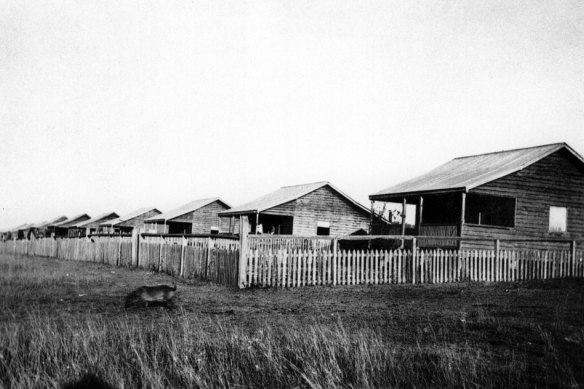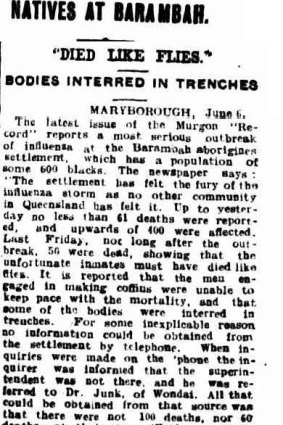This was published 5 years ago
History shows virus could be ‘catastrophic’ for Indigenous communities
Prime Minister Scott Morrison has announced strict measures to protect "sensitive" remote Indigenous communities from a potential COVID-19 outbreak, banning all non-essential travel to and from remote areas under the Biosecurity Act.
Policy makers didn't have to look too far into the history books to understand why these precautions were so urgently needed.

Cottages at the Barambah Aboriginal Settlement in Queensland in 1919.Credit: State Library of Queensland
In 1919, when Australia was in the grip of the Spanish influenza, a small Aboriginal community in Queensland would become one of the worst-affected places in the country, though the history remains largely unknown.
The virus reached the government-run Barambah Aboriginal Settlement, three hours north of Brisbane, in late May, 1919. The town is now called Cherbourg.
The local Indigenous people "died like flies", a Brisbane newspaper reported at the time.
All but 10 of the 600-strong population were infected. Within three weeks, almost 90 people had died - a mortality rate of almost 15 per cent. The dead were buried in mass graves.
“You can imagine a community where 10 people out of 600 are able to get up and walk around - it's completely catastrophic. It's complete dislocation, nothing is functioning normally,” said historian Matthew Wengert, author of City in Masks: How Brisbane fought the Spanish Flu epidemic in 1919.
It’s unclear how the virus got into the community, which was only accessible via one road. The state government had shut the Queensland border and closed access to the Barambah settlement to all except the government medical officer.
“I don't think anyone can ever be certain about how the virus got into Barambah, but when it got in, it went through the place like a storm,” Mr Wengert said.

An excerpt from an article published in the Brisbane Courier on June 7, 1919.
“It was a complete disaster unlike anything else in mainstream Australia.”
Most residents had been forcibly relocated to the settlement from central and far north Queensland, and were unused to Barambah’s frosts and chilly winters. Mr Wengert said it was likely none had ever experienced the flu before.
“The fact that it got in is shameful, because the government was responsible for those people. They were living there because the government forced them to live there, and then the government knew that the flu was coming.”
Mr Wengert says the history lesson is clear: “If you have a rule, then it should be followed.”
Cherbourg elder Eric Law says the community is now “much better resourced” to cope with an outbreak than it was a century ago, but is still vulnerable due to overcrowded housing and high rates of chronic disease.
The Cherbourg Aboriginal Shire Council has banned community access for non-essential services. There has been one confirmed case of coronavirus in Kingaroy, 40 minutes from Cherbourg.
“I think people are cautious, more than worried. I think they're taking this threat seriously, which is good,” said Mr Law.
The Wakka Wakka man grew up hearing stories about the Spanish influenza from his father, a World War One veteran who was on a ship home when the virus hit Australia.
He hopes people will heed the lessons of the past.
“I think this is a good time for everybody in Australia to worry about somebody else," he said.
“It's about that old Australian tradition of looking after your mate, and this is when we need to be doing it and not just talking about it.”